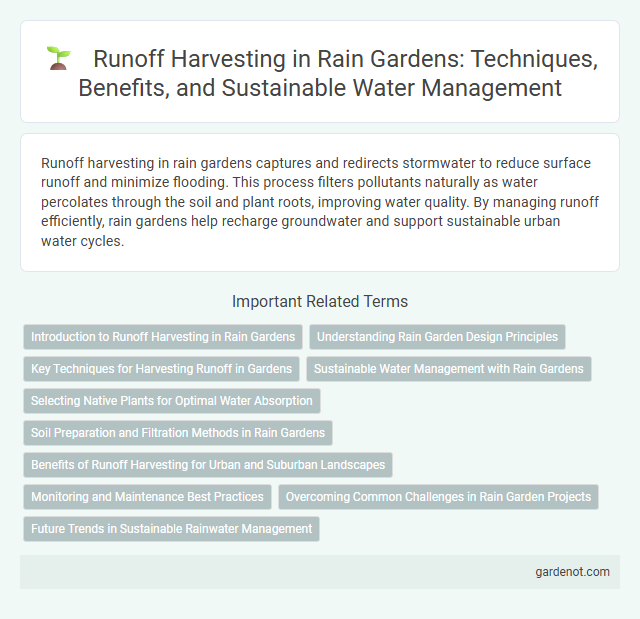Runoff harvesting in rain gardens captures and redirects stormwater to reduce surface runoff and minimize flooding. This process filters pollutants naturally as water percolates through the soil and plant roots, improving water quality. By managing runoff efficiently, rain gardens help recharge groundwater and support sustainable urban water cycles.
Introduction to Runoff Harvesting in Rain Gardens
Runoff harvesting in rain gardens involves capturing and storing stormwater from impervious surfaces such as rooftops and pavements to reduce flood risk and promote groundwater recharge. This sustainable water management practice uses soil and vegetation to filter pollutants and improve water quality before infiltration. Implementing runoff harvesting enhances urban resilience by decreasing surface runoff volume and mitigating erosion.
Understanding Rain Garden Design Principles
Runoff harvesting in rain garden design emphasizes capturing and infiltrating stormwater to reduce surface runoff and improve water quality. Key principles include selecting native, deep-rooted plants to enhance soil permeability, creating appropriately sized basins to accommodate anticipated rainfall volume, and ensuring proper grading for effective water retention and slow drainage. Incorporating these elements optimizes water absorption, mitigates flooding risks, and supports ecological health.
Key Techniques for Harvesting Runoff in Gardens
Rain garden runoff harvesting relies on key techniques such as contouring the landscape to direct water flow, using permeable soil layers for enhanced infiltration, and integrating native plants with deep root systems to maximize water absorption. Incorporating rain barrels or cisterns at strategic points collects excess runoff for later irrigation, reducing water waste and minimizing erosion. Installing swales or bioswales channels runoff efficiently while filtering pollutants before they enter groundwater or storm drains.
Sustainable Water Management with Rain Gardens
Rain gardens play a crucial role in sustainable water management by efficiently capturing and filtering stormwater runoff, reducing the burden on urban drainage systems. These gardens use native plants and engineered soils to enhance infiltration, minimize pollutants, and replenish groundwater supplies. Implementing rain gardens in urban landscapes supports runoff harvesting efforts, mitigates flooding risks, and promotes ecological balance.
Selecting Native Plants for Optimal Water Absorption
Selecting native plants for runoff harvesting in rain gardens enhances water absorption by utilizing species adapted to local soil and climate conditions. Deep-rooted native grasses, sedges, and wildflowers improve soil permeability, reducing surface runoff and promoting groundwater recharge. These plants also support local biodiversity, creating a resilient ecosystem that efficiently manages stormwater.
Soil Preparation and Filtration Methods in Rain Gardens
Effective soil preparation in rain gardens involves amending native soil with compost and sand to enhance permeability and nutrient retention, facilitating efficient runoff harvesting. Filtration methods utilize layered substrates, including gravel and organic mulch, to trap sediments and pollutants while promoting infiltration and minimizing runoff volume. Optimized soil structure and filtration media support improved water absorption, reducing urban stormwater impact and enhancing groundwater recharge.
Benefits of Runoff Harvesting for Urban and Suburban Landscapes
Runoff harvesting in urban and suburban landscapes reduces stormwater runoff, minimizing flooding and erosion while replenishing groundwater supplies. It improves water quality by filtering pollutants through rain gardens, promoting healthier ecosystems and reducing strain on municipal water treatment systems. Implementing runoff harvesting enhances urban green spaces, supports biodiversity, and lowers water bills through efficient reuse of captured rainwater.
Monitoring and Maintenance Best Practices
Effective runoff harvesting in rain gardens requires regular monitoring of water levels, soil moisture, and vegetation health to ensure optimal absorption and filtration. Routine maintenance such as removing debris, controlling invasive plant species, and inspecting inlet and outlet structures prevents clogging and maximizes water retention. Employing tools like moisture sensors and scheduled inspections enhances the longevity and performance of runoff harvesting systems in rain gardens.
Overcoming Common Challenges in Rain Garden Projects
Runoff harvesting in rain garden projects often faces challenges such as soil compaction, improper grading, and limited space, which can reduce infiltration and water retention efficiency. Implementing soil amendments, ensuring proper slope design, and selecting appropriate native plant species help optimize water absorption and pollutant removal. Regular maintenance including sediment removal and inspection ensures sustained functionality and prevents clogging or overflow issues.
Future Trends in Sustainable Rainwater Management
Runoff harvesting in rain gardens is advancing towards integrated smart systems that optimize water capture and reuse, reducing urban flood risks and enhancing groundwater recharge. Innovations include permeable surfaces combined with sensor-driven irrigation controls that dynamically adjust based on rainfall patterns and soil moisture levels. Future trends emphasize green infrastructure synergy, promoting resilient urban ecosystems through decentralized, efficient water management solutions.
Runoff harvesting Infographic

 gardenot.com
gardenot.com